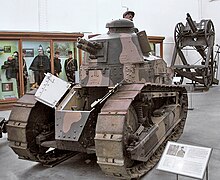Belgian combat vehicles of World War II
This article includes a list of general references, but it lacks sufficient corresponding inline citations. (December 2008) |
The Belgian Army had approximately 200 combat vehicles at the time of the German invasion in May 1940. They were not organized into units of their own, but were spread out in various infantry and cavalry divisions for use as support weapons. The Belgian Army viewed their combat vehicles as defensive weapons. The practice of spreading out combat vehicles in so called "penny packets" (also used in the French Army at the same time) left them at a disadvantage against the German invaders, who concentrated their armour into organic units that could act on their own and that outnumbered the opposing vehicles even if units of the same size faced off against each other.
T15 light tank

The T15 was a version of the British "Commercial Light Tank Vickers Carden-Loyd 4 ton". They had a two-man crew and were armed with a 13.2 mm French Hotchkiss machine gun mounted in the turret. A total of 42 of these tanks were assigned to Belgian units.
T13 tank destroyer, models B1, B2, and B3

The T13 series were very similar to the T15; the only major difference was that the main armament was a 47 mm anti-tank gun instead of a machine gun. They were regarded as tank destroyers; except the first model (B1) all had fully rotating turrets.
Total production for the T13:
- T13 B1 - 35 produced.[1]
- T13 B2 - 14 produced. These started their life as unarmed Carden Loyd tankettes which were modified and equipped with a turret with a C.47 gun in 1936.
- T13 B3 150 produced. Entered service in 1937.
The Wehrmacht operated some captured T13s during the first years of the war, as the T13 had a more powerful main gun than the Panzer I and Panzer II, common German tanks in the early war years.
There is a T13 B2 on display at Brussels Tank Museum.
ACG-1 tank

The Renault AMC 35 tank, also designated ACG1, was armed with a 47 mm gun and a coaxial machine gun. 25 of these tanks were ordered although only 12 were accepted into the Belgian army due to supply problems. The Belgian ACG1 and the AMC 35 had different turrets. The Belgian Army disliked the layout of the AMC 35 turret, and so designed their own. Instead of waiting for the other tanks to arrive the Belgian army created the T-13 B3, also armed with a 47 mm C.47 gun. Eight of the ACG1 were in front line units at the start of the 1940 campaign. The ACG1 had a reputation for mechanical difficulties which caused a dispute with the French manufacturer, and slowed deliveries until the problems were solved. The 47 mm main gun in the ACG1 was the same anti-tank gun then in service with the Belgian Army.
Renault FT tank

The Belgian army had 75 Renault FT tanks (of World War I vintage) at the start of World War II. The Belgian Army had two types of FT tanks, the Char canon armed with a short 37 mm Puteaux SA-18 gun and the Char mitrailleuse armed with a machine gun. Unlike the French Army, the Belgian Army had withdrawn all FT tanks from front line service before World War II. They remained in storage depots during the 1940 campaign.
Combat vehicles used after the liberation of Belgium (late 1944)
After Belgium's liberation, the Belgian army used American and British equipment until the end of the war.
See also
- Belgium in World War II
- Order of battle of armour units of the Belgian Army in May 1940
- List of World War II military vehicles by country
